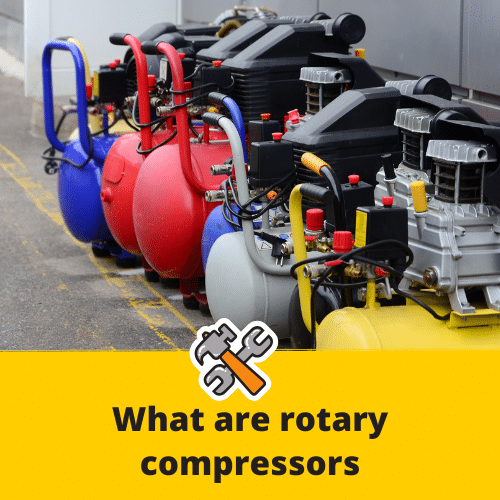Want to know what are rotary compressors?
Well awesome - look no further. You are in the right place.
in this ToolsGaloreHQ guide, you will learn.
- What makes a rotary compressor;
- Key components worth considering;
- Interesting FAQs; and
- So Much More.

Rotary compressors, particularly rotary screw compressors, play a crucial role in many industrial applications.
These machines utilize two helical rotors to compress air efficiently, providing a constant airflow. Their design eliminates the need for valves, which enhances reliability and reduces maintenance.
Understanding the key components and operational mechanics can reveal their significance in optimizing performance and energy efficiency. However, the nuances of their functionality and types warrant a closer look.
Why this guide on what is a rotary screw compressor
Understanding rotary screw compressors is essential for industries that rely on efficient and reliable air compression solutions.
This guide aims to demystify the intricacies of rotary screw compressors, empowering individuals and organizations to make informed decisions. By providing clear insights into their operation and benefits, the guide liberates users from confusion, enabling them to harness the full potential of these machines.
Knowledge of rotary screw compressors fosters autonomy in selecting the right equipment, optimizing performance, and reducing energy costs. Furthermore, this understanding cultivates a sense of confidence, allowing industries to thrive without being hindered by inefficiencies.
Ultimately, this guide serves as a beacon of clarity in a complex landscape, encouraging innovation and progress in air compression technology.
Read More:>>> Have you ever wondered how to saw in circles?
Key components of a rotary screw compressor
The key components of a rotary screw compressor play a crucial role in its operation and efficiency.
These include the air intake system, compression element, drive mechanism, cooling system, and control panel, each contributing to the overall performance of the unit.
Understanding these elements is essential for optimizing compressor functionality and maintenance.
Air Intake System
While operating efficiently is crucial for any rotary screw compressor, the air intake system serves as a vital component in this process. This system is responsible for drawing ambient air into the compressor, where it begins its journey towards compression.
Typically, the air enters through a filter that removes impurities, ensuring that contaminants do not compromise performance. Following filtration, the air travels through an intake valve before reaching the rotors.
The design of the air intake system significantly influences the compressor's efficiency, impacting how effectively it can convert low-pressure air into high-pressure output. A well-designed intake system not only enhances operational efficiency but also contributes to the longevity of the compressor, promoting sustainable practices in various industrial applications.
Read More:>>> Test IAC with a multimeter
Compression Element
Following the intake process, the compression element serves as the heart of a rotary screw compressor, playing a pivotal role in transforming low-pressure air into high-pressure output.
It consists of two interlocking helical rotors—one male and one female—designed to trap and compress air efficiently. As the rotors turn, they reduce the volume of the trapped air, thereby increasing its pressure. This process occurs without any valves, which enhances operational efficiency and allows for continuous air delivery.
Additionally, oil may be injected to provide lubrication and cooling, ensuring smooth operation while minimizing wear. The compression element's design emphasizes reliability, making it an integral component for those seeking effective and durable air compression solutions.
Drive Mechanism
This mechanism incorporates various drive types, including belt, gear, and direct drive systems. The belt drive offers a robust and cost-effective option, while gear drives provide a quieter operation and enhanced energy efficiency.
Direct drive systems, known for their highest efficiency, ensure low energy consumption and minimal noise. Each drive type is designed to cater to specific operational needs, allowing users to select based on performance requirements and budget constraints.
Read More:>>> High quality table saws less than $1000
Cooling System
The cooling system in a rotary screw compressor is a critical component that ensures optimal performance and longevity. This system primarily utilizes oil, which is injected into the rotors, serving a dual purpose: it reduces temperature and provides a hydraulic seal.
By maintaining an efficient cooling process, the compressor operates smoothly, preventing overheating and potential damage. The design allows for continuous operation, making it ideal for demanding applications.
Additionally, effective cooling enhances energy efficiency, leading to reduced operational costs. As a result, the compressor can sustain high performance levels while promoting a longer service life, ultimately liberating operators from frequent maintenance concerns and enhancing productivity across various industrial settings.
Control Panel
In a rotary screw compressor, the control panel serves as the central hub for monitoring and managing the compressor's operation. It provides real-time data on performance metrics, allowing operators to make informed decisions. Key features include pressure gauges, temperature indicators, and control switches, which enhance operational efficiency.
Feature | Function | Benefit |
|---|---|---|
Pressure Gauge | Displays system pressure | Ensures optimal performance |
Temperature Indicator | Monitors operating temperature | Prevents overheating |
Control Switches | Adjusts compressor settings | Increases flexibility and control |
This control panel empowers users to maintain and optimize the compressor, ensuring reliability and efficiency in operations, ultimately liberating them from the constraints of inefficiency.
Deep dive review of rotary screw compressors
Rotary screw compressors represent a pivotal advancement in compressed air technology, distinguished by their efficient positive displacement mechanism. Utilizing two intermeshing helical rotors, these compressors effectively trap and compress air, facilitating continuous operation without the interruptions common to other types.
Their design minimizes noise and energy consumption, aligning with modern demands for sustainable practices. The availability of both oil-injected and oil-free models broadens their application across industries requiring varying purity levels.
With innovations in technology, such as variable speed drives, rotary screw compressors adapt to dynamic air needs, enhancing operational efficiency. Their robust construction ensures longevity and reliability, empowering industries to achieve greater productivity while maintaining environmental consciousness and operational freedom.
Frequently Asked Questions
How Do I Choose the Right Size Rotary Compressor for My Application?
To choose the right size rotary compressor, one must assess the specific air demand of the application, including peak usage and continuous flow requirements.
Considering the horsepower needed based on operational tasks, along with the desired pressure levels, is vital.
Additionally, evaluating the compressor's duty cycle and efficiency ratings will ensure optimal performance.
Consulting with experts can provide valuable insights, guiding users toward a compressor that aligns perfectly with their needs for liberation and efficiency.
What Is the Average Lifespan of a Rotary Screw Compressor?
The average lifespan of a rotary screw compressor typically ranges from 10 to 15 years, depending on factors such as maintenance, operating conditions, and usage frequency.
With proper care, including regular servicing and timely oil changes, these compressors can achieve optimal performance throughout their lifespan.
Additionally, advancements in technology may enhance durability, allowing some units to function effectively beyond the typical range, providing users with greater value and reliability in their operations.
Can Rotary Compressors Handle Moisture in Compressed Air?
Rotary compressors can manage moisture in compressed air, but their effectiveness largely depends on the specific model and application.
Generally, these compressors may require additional moisture separation equipment to prevent water accumulation, ensuring optimal performance. While some models are designed to reduce moisture, excessive humidity can lead to operational issues.
Therefore, integrating moisture control systems is advisable for achieving high-quality compressed air and protecting downstream equipment from potential damage.
What Maintenance Is Required for Rotary Compressors?
Regular maintenance of rotary compressors involves checking and replacing filters, inspecting oil levels, and monitoring temperature and pressure settings.
Routine cleaning of intake and exhaust areas is essential to ensure optimal airflow. Additionally, lubrication of moving parts is crucial to reduce friction and wear.
Scheduled inspections by qualified technicians can identify potential issues before they escalate, ensuring reliable performance.
Commitment to maintenance ultimately enhances efficiency, prolongs lifespan, and supports uninterrupted operation.
Are Rotary Compressors Energy Efficient Compared to Other Types?
Rotary compressors are recognized for their energy efficiency, often outperforming traditional types.
Their design allows for continuous operation without frequent on/off cycles, which minimizes energy consumption.
Moreover, advancements in technology, such as variable speed drives, further enhance their efficiency by adjusting power usage according to demand.
This not only leads to reduced operational costs but also supports a more sustainable approach, appealing to those seeking liberation from excessive energy expenditure.
Final Thoughts on what is a rotary screw compressor
A rotary screw compressor embodies a sophisticated solution for industrial air compression needs. This technology operates on the principle of positive displacement, utilizing helical rotors to efficiently compress air with minimal energy consumption.
Unlike traditional compressors, rotary screw compressors facilitate continuous operation, reducing downtime and enhancing productivity. Their quiet performance and compact design allow for closer placement to work areas, promoting a liberated workspace.
Available in both oil-lubricated and oil-free models, they cater to diverse industry requirements, ensuring air quality and reliability. With a long lifespan and minimal maintenance needs, rotary screw compressors represent a forward-thinking choice for businesses seeking efficiency and sustainability in their operations, unlocking the potential for greater innovation and growth.





